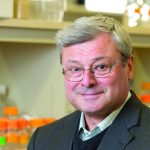An Age-Old Problem
Biology of Aging
Principal Investigator: John Sedivy, PhD
- $9.7 million in total funding, over five years
- 3 institutional partners: Brown University, New York University University of Rochester
Over the last few years, scientists—including a team at Brown—have produced mounting evidence that mobility within the genome of potentially harmful DNA snippets, called retrotransposable elements, may cause health problems associated with aging (see Brown Medicine, Winter 2016).

John Sedivy
With a new $9.7 million, five-year NIH grant, researchers at Brown, New York University, and the University of Rochester will collaborate to further strengthen the evidence and to advance toward the goal of applying the findings medically.
“There are a lot of provocative data and a lot of very cool ideas, but the issue now is how to nail this down,” says John Sedivy, PhD, the Hermon C. Bumpus Professor of Biology and principal investigator of the grant. “Let’s take the bull by the horns and see what’s really going on. Is this a legitimate mechanism of aging and can we control it for therapeutic purposes?”
Previous studies have shown that as cells become senescent, they lose their ability to prevent retrotransposable elements from spreading into new places in the genome. In three new projects supported by two core facilities, the grant will spur the study of how retrotransposable elements function in cells and how their activity might cause specific diseases, and test possible ways of suppressing that activity. The researchers will work with not only human cells but also mice and fruit flies (Drosophila), where they can ask more direct questions, obtain faster answers, and therefore better inform eventual interventions for people.
The results could shed important light on the health consequences of retrotransposable element activity, Sedivy says. Experiments demonstrating the best interventions could then be translated into future human clinical trials.
The Grant Will Fund Three Projects:
- “Regulation of a Retrotransposable Element Activity in the Cellular Senescence and Aging,” John Sedivy;
- “Regulation of the Retrotransposable Element Activity in Drosophila,” Stephen Helfand, MD, professor of biology:
- Repression of the Retrotransposable Elements by the Longevity Gene SIRT6,” Vera Gorbunova, PhD, University of Rochester:
And Three Cores:
- Retrotransposon Engineering and Genomics Core, led by Jef Boeke, PhD, New York University School of Medicine;
- Mouse Intervention and Ageing Core, led by Andrei Seluanov, PhD, University of Rochester; and
- Administrative Core, led by John Sedivy at Brown.




